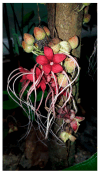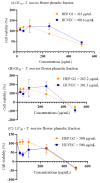Theobroma mariae: Bioactive Compound-Rich Flowers
- PMID: 39942940
- PMCID: PMC11820393
- DOI: 10.3390/plants14030377
Theobroma mariae: Bioactive Compound-Rich Flowers
Abstract
Edible flowers have gained attention as unconventional food sources due to their nutritional and functional properties. This study provides novel information on the chemical composition, cytotoxicity and antiproliferative effects of Theobroma mariae flowers. The objective of this paper was to identify bioactive compounds in its flowers using one- and two-dimensional nuclear magnetic resonance (NMR) spectroscopy and liquid chromatography coupled with high-resolution mass spectrometry (LC-HRMS). The phenolic fraction of the flowers revealed bioactive compounds such as hyperoside, guaijaverin, astragalin, juglalin, and kaempferol. The results confirmed the potential of T. mariae flowers as a source of phenolic compounds, emphasizing their feasibility for possible applications in the development of functional foods. Moreover, the antiproliferative assay demonstrated that the phenolic fraction inhibits cell proliferation (GI50) while presenting low cytotoxicity in both cancer and normal cells.
Keywords: LC-HRMS; Malvaceae; NMR; antiproliferative; citotoxicity; food plant; phenolics compounds.
Conflict of interest statement
The authors declare no conflicts of interest.
Figures



References
-
- Mar J.M., da Silva L.S., Moreira W.P., Biondo M.M., Pontes F.L.D., Campos F.R., Kinupp V.F., Campelo P.H., Sanches E.A., Bezerra J.d.A. Edible flowers from Theobroma speciosum: Aqueous extract rich in antioxidant compounds. Food Chem. 2021;356:129723. doi: 10.1016/j.foodchem.2021.129723. - DOI - PubMed
-
- Mar J.M., Fonseca Júnior E.Q., Corrêa R.F., Campelo P.H., Sanches E.A., Bezerra J.d.A. Theobroma spp.: A review of it’s chemical and innovation potential for the food industry. Food Chem. Adv. 2024;4:100683. doi: 10.1016/j.focha.2024.100683. - DOI
-
- Jacob M.C.M., Albuquerque U.P., editors. Local Food Plants of Brazil. 1st ed. Springer; Berlin/Heidelberg, Germany: 2021.
-
- de Oliveira T.B., Rogero M.M., Genovese M.I. Poliphenolic-rich extracts from cocoa (Theobroma cacao L.) and cupuassu (Theobroma grandiflorum Willd. Ex Spreng. K. Shum) Liquors: A comparison of metabolic effects in high-fat fed rats. PharmaNutrition. 2015;3:20–28. doi: 10.1016/j.phanu.2015.01.002. - DOI
-
- Kinupp V.F., Lorenzi H.H. Plantas Alimenticias Não Convencionais (PANC) No Brasil: Guia de Identificação, Aspectos Nutricionais e Receitas Ilustradas. 1st ed. Instituto Plantarum; São Paulo, Brasil: 2014.
Grants and funding
- Process number 01.02.016301.01140/2023-33, Chamada Pública n. 003/2022 - Jovens Doutores, Edital n. 013/2022-Produtividade-CT&I/Fundação de Amparo à Pesquisa do Estado do Amazonas
- Process number 311522/ 2020-3; 422096/2021-0; 306799/2021-9/National Council for Scientific and Technological Development
- Process number APQ-04299-22; APQ02221-24/Fundação de Amparo à Pesquisa do Estado de Minas Gerais
LinkOut - more resources
Full Text Sources

